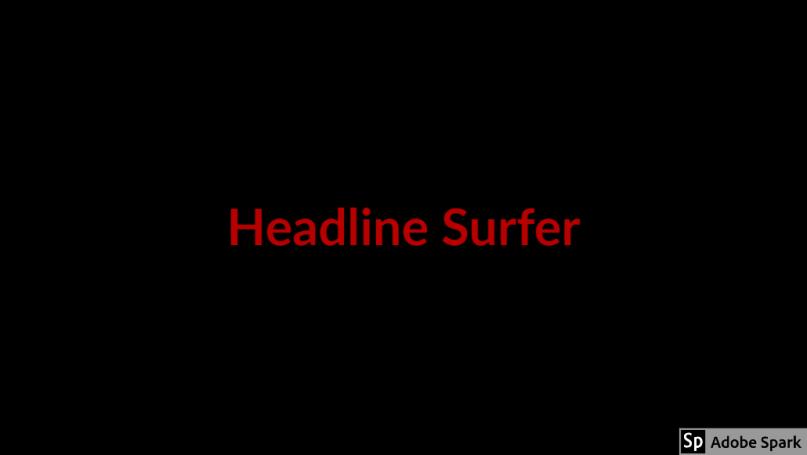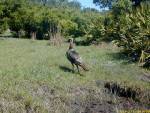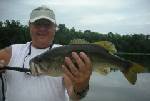


 Photos by Capt. Budd Neviaser. At left, this male wild turkey will soon the target of many men and women as the Spring hunt will be coming up March 21 - April 26. In the middle, in a casual glance, you may believe that you are viewing a group of does. At this time of year, bucks have lost their antlers and aside from sexual difference, the bucks and does look the same. At right, Richard Colesanti from Port Orange shows off a nice large mouth bass proving that a "blind hog finds an acorn very once in a while".
Photos by Capt. Budd Neviaser. At left, this male wild turkey will soon the target of many men and women as the Spring hunt will be coming up March 21 - April 26. In the middle, in a casual glance, you may believe that you are viewing a group of does. At this time of year, bucks have lost their antlers and aside from sexual difference, the bucks and does look the same. At right, Richard Colesanti from Port Orange shows off a nice large mouth bass proving that a "blind hog finds an acorn very once in a while".
During the winter months, Mother Nature loves to play tricks on those who try to enjoy the aquatic objects of her affection – specifically the fish.
Seas can turn rough unexpectedly and the river can go from a tranquil state to a boat-slapping, wet, ride home It can be T-shirt temperatures in the morning of any given day and the need of multiple layers of clothing for the ride home. Even those with years of experience at times get fooled. Often in the winter months, the gin clear water of the rivers, produced by precipitation of solids in response to cooler water temperatures, sometimes reveals large fish -sometimes the size of small logs - lying in the cool water warming themselves in the sun.
The overly anxious angler can throw everything in his array of tackle without the slightest sign that the fish even was aware of the fact that there was a “delicious – but deadly” – meal in the area. More often than not, when it comes to partaking these offers the fish will show as much enthusiasm as would the average angler going to Burger King for a Double Whopper five minutes after he/she finished the big dessert following three helpings of a Thanksgiving dinner. So what do you do about it? Enjoy it -- you cannot change it.
Once more, we have been blessed with no reports of Karenia brevis, the Florida red tide organism, being detected in the samples collected from Mosquito Lagoon, Indian River lagoon, or the Banana River, thus far this month. On some days recently even the large, multi-passenger, head boats would not go out to sea. On the days in-between those times, it has been good fishing. The Offshore charter trips report that Cobia action is good especially on the bottom.
Catches of gag and red grouper have been slow compared to a couple of months ago. The genuine Red Snapper bite remains terrific. While there are many undersized red snapper, many boats are still limiting out. The bite on very large triggerfish, lane, mutton and mangrove snapper and the tasty black sea bass are still good on the bottom. In the surf, whiting continue to produce most of the action.
There are still plenty of small bluefish around and are being caught as well as pompano, which seem to bite best in the morning. Best baits still seem to be sand fleas and clams.
The Rich Brothers went fishing earlier this week and each came home with one small bluefish (neither of which met the minimum size limit of twelve inches to the fork – when questioned about the size, they each pleaded ignorance – of which, being yankees, they each had plenty). I politely told them that I did not think that their individual catches would serve to feed their families but they each said that they would prepare it and use it as a special appetizer. I suggested that they try giving their families a lettuce and tomato salad instead and feed their bluefish to the cat. In Ponce Inlet, the sheepshead bite are producing most of the action.
Capt Fred Robert caught several redfish in the channel on the bottom using live pinfish. Size was, however, nothing spectacular. In the river along the docks, he landed several snook, using a long light weight leader, on a circle hook and small pinfish, shrimp, and thread finned herring. Some report frequent catches of small sharks. Others report good, black drum activity around the bridges. In the creeks redfish, some smaller tarpon and snook are biting well on shrimp. Redfish continue to be hot in the Tomoka area using shrimp. Trout and mangrove snapper are frequently being hooked up in the Tomoka area as well.
Fortunately the recent cold period did not produce a snook kill and the snook bite has been doing well. In the lagoon, Capt. John Tarr says the bite goes down when the water warms. The bite is best in the center of the lagoon. The 2008 Manatee Mortality Information page has been updated with
Preliminary December mortality numbers and the 2008 Yearly Summary. The information can be found at http://research.myfwc.com/features/view_article.asp?id=14855. The recreation harvest of Gag Grouper from all waters in the Gulf of Mexico is closed from Feb. 1 to March 31. This two-month closure of the recreational fishery supposedly will reduce the harvest of Gulf gag Grouper and will rebuild the population of this important species. More information can be gained online by going to MyFWC.com/marine/grouper/index.htm. As of Feb. 1, the recreational harvest season for spotted sea trout in North Florida is closed for one month to help maintain the abundance of the species. The good news is that the sport harvest of snook begins again the same date.
The harvest and possession of spotted sea trout is prohibited from Feb. 1 through March 1, in all waters north of the Flagler-Volusia line to the Florida-Georgia line in the Atlantic zone. All other areas in Florida have open season on the recreational harvest of this species. The recreational harvest season for snook reopens February in Florida’s Atlantic coastal and inland waters, including Lake Okeechobee and the Kissimmee River. Anglers may keep one snook between 28- 32 inches total length per day from these waters. Do not forget to purchase a $2 snook permit in addition to your fishing permit. Remember that snatch hooking and spearing of snook is prohibited. Further it is illegal to sell or buy snook. Snook regulations also apply in federal waters.
Also, the harvest of snook remains closed in all of Florida’s Gulf of Mexico, Everglades National Park, and the coastal and inland waters of Monroe County until March 1.
A team of scientists counted an all-time- high number of manatees during the annual manatee synoptic survey conducted the week of January 19, 2009. The Florida Fish and Wildlife Research Institute (FWRI) reported a preliminary count of 3,807 manatees statewide. A team of 21 observers from nine organizations counted 2,153 manatees on the Florida East Coast and 1,654 on the West Coast of the State.
This year’s count exceeded the previous high count done in 2001, by more than 5,600 animals. The survey conditions were very favorable for aerial observations in both of those years. Although synoptic results are not population estimates and should not be used to assess trends, the FWC is encouraged by this year’s high count. Survey results are consistent with population models that show the manatee population appears to be increasing in Northwest Florida, along the Atlantic Coast and on the upper St. Johns River.
The synoptic survey is a count of manatees over a broad area. The survey provides researches with a snapshot of manatee distribution and a minimum number of manatees in Florida waters at the time of the count. Researchers have been conducting synoptic surveys since 1991, weather permitting, to meet the State’s requirements for an annual count of manatees. Weather and manatee behavior affect synoptic survey counts. The best conditions for the synoptic survey occur during the coldest months of the year, when manatees gather at warm-water sites.
“Several cold fronts passed through Florida over a short time period, causing large numbers of manatees to move into warm-water sites, said FWRI biologist Holly Edwards.“ Good weather conditions allowed the manatees to be easily seen and counted, contributing to this year’s high count.” FWRI researchers are testing new survey methods that will provide a population estimate for Florida manatees as outlined in the FWC’s manatee management plan. The adjustments to the survey will help achieve more accurate results and reduce dependency on the weather. For more information about manatees and synoptic surveys, visit http://research.MyFWC.com To report a dead or injured manatee, call the FWC Wildlife Alert Hotline at 1-888-404-FWCC.
Here's some sad news for the yankee snow-birds: When New York Gov. David Paterson unveiled his 2009 executive budget, many New Yorkers couldn't help but snicker at such belt-tightening proposals as the 15 percent "obesity tax" on non-diet drinks. For the recreational fishing and boating industry however, particularly a new coalition called Save Boating and Fishing Jobs in New York, the sweeping set of new taxes levied at their "active" tourism industry in New York is no laughing matter.
Efforts to force saltwater anglers to buy a $19 dollar saltwater license ($40 for out of state anglers) before casting a line in New York's coastal waters would strike a heavy blow to marinas, tackle shops and marine dealers, most of whom are already suffering from a two-year-long decline in business. In addition to a saltwater license, the governor's budget would also impose a 5 percent luxury tax on all boats costing over $200,000, an increase in marina fees, an increase in state park fees and a lifting of the cap on state fuel taxes. "We're outraged that the governor would recommend not one, but five new or increased taxes targeting fishermen, boaters and the $1 billion New York recreational fishing industry," said Jim Donofrio, executive director of Recreational Fishing Alliance (RFA), a national advocacy group for recreational fishing. "We're experiencing an unprecedented downturn in fishing activity.
Even fishing from the shore will be an expensive outing under this tax plan." Joining in RFA's opposition is a coalition comprised of the National Marine Manufacturers Association (NMMA), New York Fishing Tackle Trade Association (NYFTTA), United Boatmen of New York and the New York Marine Trades Association (NYMTA). The new coalition is calling itself Save Boating and Fishing Jobs in New York. Recreational marine fishing in New York created $812 million in sales, directly supported 5,365 jobs, provided $424 million in value-added economic impact and $126 million in tax revenue, according to a 2006 National Marine Fisheries Service (NMFS) study.
NMFS excluded significant revenue from excise taxes applied to fishing trips, bait and tackle sales, and marine fuel. "Fishermen already pay a huge amount in taxes to enjoy their sport," Donofrio said. "The state should create more incentives to spur its growth. A healthy, vibrant recreational fishery can increase revenue. Now is the time to support this important industry, not stifle it."
Coalition leaders believe that efforts by the state government to levy increased fees on regional fishing and boating could seriously impact New York's marine tourism industry. "When a politician implements a $2 cigarette tax or a 15% obesity tax, he'll tell you unabashedly that it's designed in part to stop people from using these products," said Jim Hutchinson, Jr. executive editor of The Fisherman. "Likewise, this over-taxation of boating and fishing will push many people and businesses over the edge. Fishermen will stay home, small businesses will be hurt and the state will lose more in general tax revenue than it gains from these sweeping taxes."
The NYFTTA has worked in recent months with the New York State Department of Environmental Conservation (NYS DEC) to design a marine district saltwater registry that will minimize the cost to fishermen while increasing federal funding of fisheries management and boating infrastructure. "We hope the governor and legislature will drop the tax and instead support the saltwater registry being developed by the NYS DEC," said an obviously frustrated Gene Young, President of NYFTTA. "The Governor's license plan will smash open the lock box that now prevents the diversion of funds earmarked for marine conservation. The license fees will disappear into a general conservation fund, and the net effect will be a cutback in marine fisheries management." "It has become tough enough to enjoy fishing in just the past few years. Summer fluke season has been shortened, winter flounder fishing soon will be banned and there's lower take limits on other local game fish," said Philip Curcio of United Boatmen of New York, a trade organization representing the voice of the recreational charter and party boat industry in New York. To learn more and to send a form letter to Governor Paterson, visit the RFA website at www.joinrfa.org.
A report from Florida CCA reveals the economic reality for Gulf Grouper reveals that in an important development in the debate over the proper management of gag and red grouper in the Gulf of Mexico, a newly released economic study of the fishery finds that a 100 percent allocation to the recreational sector would yield maximum economic value to society. Gulf grouper has been a hotly debated issue in the Gulf of Mexico Fishery Management Council, which is meeting this week in Mississippi to discuss grouper management among other issues.
The study’s economic findings should add a new twist to the management of this intensely debated fishery. “Most in the recreational community would not be surprised by these results, but I think many federal managers have ignored this reality,” said Frederic Miller, chairman of the Coastal Conservation Association National Government Relations Committee. “This fishery would yield more jobs and economic output from a 100 percent recreational allocation.”
The study was conducted by Brad Gentner, who ran the recreational economics data collection program for the National Marine Fisheries Service (NMFS) for eight years before starting his own company, Gentner Consulting Group. As a NMFS Economist in the Division of Economics and Social Analysis, he specialized in survey design, recreational fisheries demand and welfare analysis, non-market valuation, and economic impact modeling for recreational fisheries. Gentner’s study used economics to analyze grouper allocations in the Gulf of Mexico.
Among other findings, Gentner's analysis revealed that recreational gag grouper fishing generates $107 million in value added, $60.8 million in income and supports 1,513 jobs while red grouper fishing generates $35.2 million in value added, $20 million in income and supports 501 jobs. Commercial gag grouper fishing generates $16 million in valued added, $7.7 million in income and supports 322 jobs while red grouper fishing generate $49 million in valued added, $23.7 million in income and supports 988 jobs. The majority of the economic impacts in the commercial sector in both fisheries occur in the retail and restaurant sectors, and Gentner concludes that those sectors would experience very few losses with a 100 percent recreational allocation.
“This study cannot be ignored," said Chester Brewer, vice chairman of the CCA National Government Relations Committee. "More than ever, allocation is a critical component of virtually every fishery management system. With this information in hand, it is outrageous that the Gulf Council should establish an Individual Fishing Quota system for Gulf grouper without first addressing the allocation issue.” The Mid-coast Chapter of Florida CCA will be holding its annual banquet on Feb. 6, at the Riverside Pavilion; 3431 South Ridgewood Ave. Port Orange, at starting at 6 p.m. Banquet tickets are $75 per person (includes Dinner and CCA membership), $110 per couple (includes2 Dinners and 2 CCA memberships), or if you prefer a sponsor's table ($800 - which includes 8 Dinners, 8 CCA memberships & premium sponsors gifts). As a 501-c-3 corporation, purchases are eligible for tax deduction of $44 for a single ticket, $53 for a couple tickets, and $356 for a corporate membership. For tickets, please call me, Capt. Budd Neviaser at (386) 566-3137 or Rich Adamovic at (386) 761-1794 or (386) 235-3889. This is an opportunity for a great deal of fun and fantastic eating. CCA Florida and The Wildlife Foundation of Florida need your help.
The Florida Marine Fisheries Enhancement Initiative Partners have submitted a comprehensive hatchery proposal to be considered as part of the upcoming federal economic stimulus package. The package is being submitted to Gov. Crist's office and to Florida's congressional delegation for support and approval, pending appropriation of Federal infrastructure dollars appropriated to Florida for stimulating the Florida economy. Recreational saltwater fishing represents a $5 billion industry annually to the Florida economy.
Thirty-nine percent of the recreational saltwater fishing in the U.S. takes place in Florida and this demand has been growing at a project rate of 7 percent per year for the last five years. While recreational saltwater fishing represents an important green growth industry for Florida, sustaining the habitat and components of the recreational fishery are becoming increasingly more important.
The hatchery projects within the proposed stimulus package would construct seven recreational marine hatcheries on the East and West coasts, creating 3,129 immediate jobs and 169 permanent green jobs for Florida at a cost of $138 million. An additional $10 million has been requested for critical fish habitat restoration for the Indian River Lagoon and Tampa Bay; an investment creating an additional 350 immediate green jobs for local communities. State-wide angler and boater support has been strong and growing for the Initiative. The governor and elected state representatives will have the final decision-making authority in use of the Federal appropriations.
As the details of the economic stimulus package have been communicated, it is clear that supporters of enhancing Florida's marine fishery need to make their preferences known in Tallahassee and Washington, DC. Contact your elected state officials today and let them know that this is the right direction for Florida’s marine fishery. For more information please visit www.supportfloridasportfish.com or contact Trip Aukeman CCAF Deputy Director 850-224-3474. If you want to send a message, go to http://www.votervoice.net/link/target/ccafl27986544.aspx
It has been written; “There is a final moment of unyielding patience which, in angling, so often makes the difference between fish and no fish..” So whether you charter, ride a head boat, run your own vessel, stay in the river, surf fish, or fish from shore or a bridge, there are fish to be caught. Fishing is not a matter of life or death, it is so much more important than that.
Tight lines,
Capt. Budd
<*)//////><
